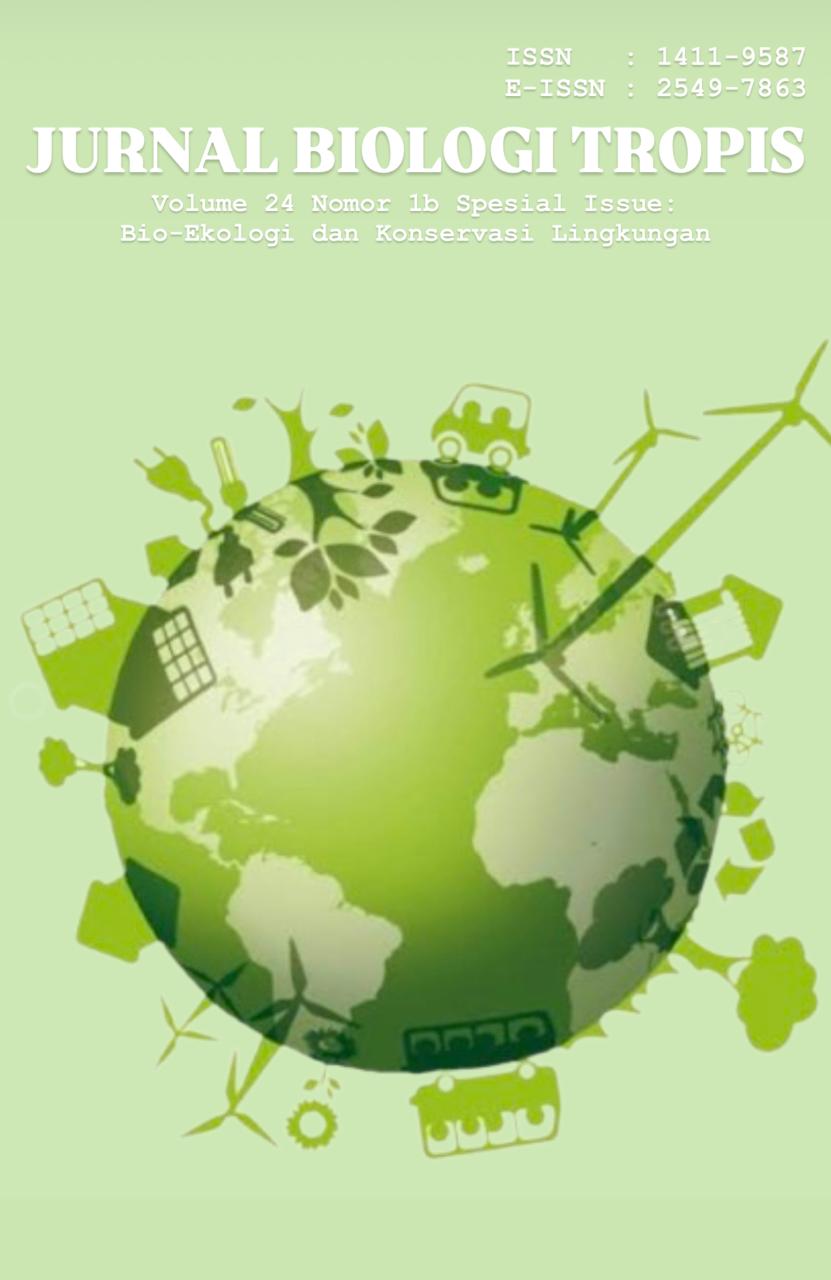Ethnobotany of Food Plants Based on Land Characteristics in Lombok Island
Authors
Khaerul Ihwan Ihwan , Baiq Naili Dewi Atika , Dian NitamiDOI:
10.29303/jbt.v24i2b.8063Published:
2024-12-15Issue:
Vol. 24 No. 2b (2024): Special IssueKeywords:
Ethnobotany, food plants, land characteristic, Lombok Island.Articles
Downloads
How to Cite
Downloads
Metrics
Abstract
The ethnobotanical study of food crops is very important to be carried out because it can be a means of natural resource conservation, social and economic sustainability of local communities. The diversity of food crops on the island of Lombok reflects the interaction between humans and the environment as well as the cultural values contained in the practice of using food crops in daily life. The objectives of this study are to: a) identify food crops on the island of Lombok based on land characteristics, b) find out the distribution of food crops on the island of Lombok based on land characteristics, and c) find out how food crops are used by the community on the island of Lombok. The sample was determined using the purposive sampling technique. Data were collected through semi-structured interviews and then plant specimens were collected accompanied by key informants in the field. Data analysis was carried out in a qualitative descriptive manner after being processed in Microsoft Excel using simple statistical techniques. Based on the results of the study, about 64 species of food crops were found. Land characteristics consist of wetlands, sandy lands, and dry lands. A total of 46 species of food crops were found in rice fields with wetland/clay characteristics. A total of 30 species of food crops were found on land with sandy characteristics and as many as 18 species of food crops were found on hilly land with dry land characteristics. The use of food crops by the community is ground as much as 10%, mashed as much as 12%, cooked as much as 60% and eaten raw as much as 40%. Based on the results of this study, it can be concluded that food crops are more commonly found on land with wetland or rice field characteristics and the use of food crops is most obtained by cooking.
References
Albuquerque, U. P., Ramos, M. A., de Lucena, R. F. P., & Alencar, N. L. (2014). Methods and techniques used to collect ethnobiological data. Methods and techniques in ethnobiology and ethnoecology, 15-37. https://link.springer.com/protocol/10.1007/978-1-4614-8636-7_2
Afriyanti, D., & Wardoyo, W. (2019). Pergeseran Konsumsi Pangan Masyarakat Lombok Timur Pasca-Globalisasi. Jurnal Agri Socio Ekonomi, 15(1), 59-72.
Brown, P. H., Zhao, F. J., & Dobermann, A. (2022). What is a plant nutrient? Changing definitions to advance science and innovation in plant nutrition. Plant and Soil, 476(1), 11-23.
Fauzy, A. (2020). Studi Etnobotani Tanaman Obat Di Wilayah Jawa Timur Dan Pemanfaatannya Sebagai Media Edukasi Masyarakat Berbasis Website. Pedago Biologi: Jurnal Pendidikan dan Pembelajaran Biologi, 8(2), 46-52. DOI: https://doi.org/10.30651/jpb.v8i2.9333
Hidayat, S. (2010). Etnobotani Masyara kat Kampung Adat Dukuh di Garut, Jawa Barat (Skripsi). Fakultas Kehutanan. Institut Pertanian Bogor
Hidayat, H. (2015). Pengelolaan Hutan Lestari: Partisipasi, Kolaborasi dan Konflik. Jakarta. Yayasan Pustaka Obor Indonesia.
Husain, P., Ihwan, K., Risfianty, D. K., Atika, B. N. D., Dewi, I. R., & Anggraeni, D. P. (2023). Peningkatan Kesadaran Masyarakat Tentang Konservasi Lingkungan Melalui Penanaman Pohon di Desa Pringgajurang Utara Kecamatan Montong Gading, Lombok Timur. Jurnal Pengabdian Magister Pendidikan IPA, 6(1), 297-302. DOI: 10.29303/jpmpi.v6i1.2939.
Jupri, A., Milenia, E. W., Jannah, W., & Husain, P. (2022). Ethnobotany of Food Plants Used by Local Communities at Joben Resort Mount Rinjani National Park, East Lombok. Jurnal Biologi Tropis. 22(3), 1025-1032. DOI: 10.29303/jbt.v22i3.4094
Kandari, L.S. Phondani, P.C. Payal, K.C. Rao, K.S. and Maikhuri, R.K. (2012). Ethnobotanical Study towards Conservation of Medicinal and Aromatic Plants in Upper Catchments of Dhauli Ganga in the Central Himalaya. Journal of Mountain Science, 9, 286-296. https://link.springer.com/article/10.1007/s11629-012-2049-7
Kurniati, Y., Hernawati, D., Putra, R.R. 2022. Etnobotani Tanaman Pangan di Desa Cigedug Kabupaten Garut. Saintifik Jurnal Matematika, Sains, dan Pembelajarannya. 8 (2): 151-158. DOI:10.31605/saintifik.v8i2.340
Pratiwi, A. R., & Hidayat, A. (2022). Etnobotani Tanaman Pangan di Pulau Lombok: Kajian Interaksi Manusia-Lingkungan dan Implikasinya terhadap Kebudayaan Lokal. Jurnal Biodiversitas Tropika, 20(1), 45-58.
Ramadhani, L., Oktavianti, T., Andriani, A., Nafsiah, N., Sihite, R. J., & Suwardi, A. B. (2021). Studi etnobotani ritual adat pernikahan Suku Tamiang di Desa Menanggini Kabupaten Aceh Tamiang Provinsi Aceh. Bioma: Jurnal Ilmiah Biologi, 10(1), 80-92.
Rustianti, I., Normagiat, S., Saputra, W., Putra, A., & Selfiany, W. O. (2022). Etnobotani Dan Pengelolaan Agroforestri Pekarangan Pada Masyarakat Transmigran Jawa Di Kabupaten Kayong Utara Kalimantan Barat. Jurnal Agriovet, 4(2), 153-172.
Rukmana, R., Mukhtar, M., & Zulkarnain. (2021). Kajian etnobotani untuk menggali potensi tanaman obat. Prosiding Seminar Nasional Biologi, 7(1), 232–236. Retrieved from http://journal.uin-alauddin.ac.id/index.php/psb/article/view/24201
Suryadharma, I. (2008). Diktat kuliah etnobotani. Jurusan Pendidikan Biologi. Fakultas Matematikan dan Ilmu Pengetahuan Alam. Yogyakarta: Universitas Negeri Yogyakarta.
Sutikno, E., & Hidayat, A. (2021). Etnobotani Tumbuhan Pangan di Pulau Lombok: Konservasi Kearifan Lokal dan Sumber Daya Alam. Jurnal Tumbuhan Pangan dan Gizi, 10(1), 27-34.
Shofiyah, A., & Hakim, L. (2020). Etnobotani Tanaman Pangan dari Hutan dan Pekarangan Rumah pada Masyarakat di Pemukiman Kondang Merak, Malang Selatan. Biotropika: Journal of Tropical Biology, 8(2), 98-105.
Smith, J., Brown, R., & Lee, C. (2018). Agricultural Diversification and Climate Change: A Review. Sustainability, 10(8), 1–16. DOI: 10.3390/su10082942.
Sutikno, E., & Hidayat, A. (2021). Etnobotani Tanaman Pangan di Pulau Lombok: Kajian Pemanfaatan dan Pengelolaan dalam Kearifan Lokal Masyarakat. Jurnal Biologi Tropika, 19(1), 1-12.
Wulandari, D. (2024). Implementasi program pemajuan kebudayaan desa: tinjauan pemberdayaan masyarakat berbasis budaya. Jurnal Pendidikan dan Kebudayaan, 9(1), 20-34. https://doi.org/10.24832/jpnk.v9i1.4489
Wuryantoro, A. M. (2017). Explorasi dan identifikasi tanaman umbi-umbian (ganyong, garut, ubi kayu, ubi jalar, talas dan suweg) di wilayah lahan kering Kabupaten Madiun. AGRI-TEK: Jurnal Ilmu Pertanian, Kehutanan dan Agroteknologi, 18(2), 72-79.
License
Copyright (c) 2024 Khaerul Ihwan Ihwan, Baiq Naili Dewi Atika, Dian Nitami

This work is licensed under a Creative Commons Attribution 4.0 International License.

Jurnal Biologi Tropis is licensed under a Creative Commons Attribution 4.0 International License.
The copyright of the received article shall be assigned to the author as the owner of the paper. The intended copyright includes the right to publish the article in various forms (including reprints). The journal maintains the publishing rights to the published articles.
Authors are permitted to disseminate published articles by sharing the link/DOI of the article at the journal. Authors are allowed to use their articles for any legal purposes deemed necessary without written permission from the journal with an acknowledgment of initial publication to this journal.


























